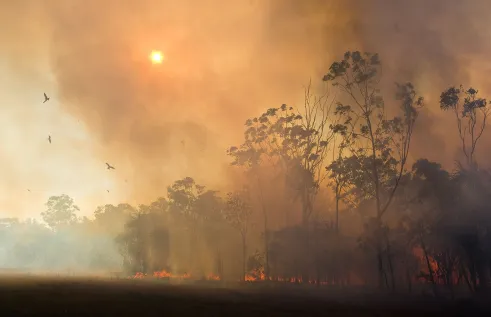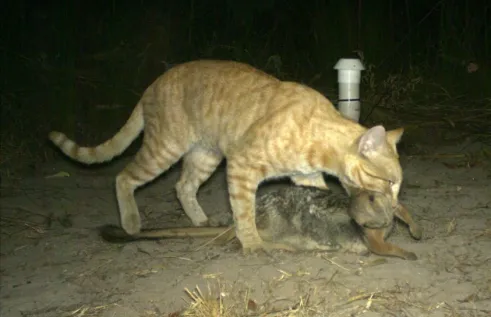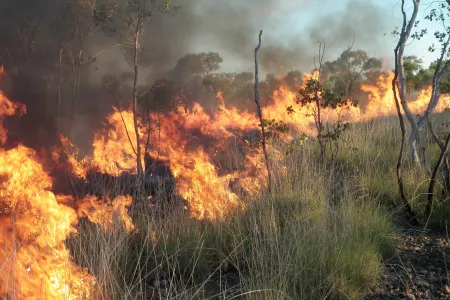Our focus
Our research investigates the sustainable management of tropical savanna landscapes.
We explore how fire has shaped and maintains the biota of tropical savannas, and how contemporary fire regimes can best be managed for biodiversity conservation, especially in relation to declining small mammals and fire-sensitive vegetation communities.
Our work falls into four themes:
- understanding the drivers of small mammal decline in northern Australia – What is the relative importance of feral cats, feral herbivores and altered fire regimes?
- tree recruitment and biomass dynamics of savannas – How do savanna trees escape the ‘fire trap’? Does fire strongly limit tree biomass in savannas?
- managing savanna fire regimes – Is prescribed burning an effective management tool in northern Australian savannas?
- pyrogeography and phytogeography – What controls the regional and global distribution of fire regimes and vegetation?
Specialist expertise and tech
We come from diverse research backgrounds, with expertise in vegetation ecology, mammal ecology, fire ecology, remote-sensing and ecological modelling. This allows us to integrate data and knowledge across disciplines and perspectives to generate exciting new insights into tropical savanna ecology.
Meet the team
This group includes, among other contributors:
Team leader
Research fellows
Why this research is important
Northern Australia’s vast savanna landscapes are a globally significant source of biodiversity. Despite the savannas remaining largely intact, with little large-scale land clearing, there are alarming declines of biodiversity and evidence of ecological dysfunction. The conservation and sustainable development of northern Australia’s savannas require an improved understanding of the threatening processes affecting biodiversity in this region, and appropriate management strategies to mitigate these threats.
Key achievements and impacts
- We collaborate with many government and non-government land management agencies across northern Australia, including Indigenous organisations - most of our work takes place on Indigenous land.
- Our work has contributed to the development of greenhouse as accounting methodologies that underpin northern Australia’s savanna fire management industry.
- Our work has high academic impact, with our work published in high-impact scientific journals.
Key projects
Stopping the decline of tree-dwelling mammals
Northern Australia’s mammals are in severe decline, and arboreal species are among those to have fared worst.
There is abundant anecdotal evidence that arboreal species are limited by the abundance of tree hollows, and that historical increases in the frequency of intense fires may be reducing hollow abundance.
Working in the North Kimberley and Tiwi‒Cobourg bioregions, the last Australian bioregions with intact mammal faunas, we are evaluating this hypothesis.
We are also exploring management options for increasing the availability of denning sites for arboreal mammals (e.g. fire management, artificial nest boxes), and evaluating the likely impact of such actions on mammal populations across northern Australia. ARC Linkage Project.
Global environmental change impacts on savanna biodiversity
The project aims to predict the biodiversity consequences of a global trend of increasing woody cover in tropical savannas, believed to be driven by a combination of elevated atmospheric CO2 concentration, climate change and management actions including fire suppression and cattle grazing.
Expected outcomes are:
- the integration of a range of modelling approaches to predict long-term impacts of environmental change on savanna biodiversity
- the identification of land-use and management strategies to best mitigate these impacts.
Likely benefits are an improved understanding of trade-offs between alternative land-uses in the savannas, including biodiversity conservation, fire management for carbon credits, and cattle grazing. ARC Future Fellowship Project.
Planning for sustainable development and biodiversity on Indigenous Lands
This project aims to develop a new approach to participatory land-use planning for sustainable development and conservation, in partnership with the Tiwi Land Council.
Planning for sustainable development is complex but vital to reconciling economic, social and conservation goals worldwide. This particularly holds for Indigenous land, with strong ties between people, land and nature, and globally important biodiversity values.
The project is evaluating land-use scenarios, including Indigenous Protected Areas, with ecological and economic models that integrate Indigenous and scientific knowledge.
Benefits include new planning tools and improved understanding of trade-offs between goals, especially on Australia’s vast Indigenous estates. ARC Linkage Project.
Mitigating cat impacts on the brush-tailed rabbit-rat
This project evaluates the extent of cat predation on the brush-tailed rabbit-rat (BTRR), whether manipulating fire frequency can mitigate cat impacts, or whether cat control is needed to secure BTRR.
We are comparing the cost-effectiveness of fire management with cat control, and utilising a long-term fire experiment to examine how fire frequency affects BTRR and cat populations, and habitat attributes required by small mammals.
We are also investigating whether fire management for carbon credits is compatible with conservation of BTRR, and make recommendations of how fire management can be improved for conservation outcomes.
How northern quolls respond to cat baiting
This research project is building on an existing large-scale feral cat baiting program in the Pilbara being undertaken by the WA Department of Biodiversity Conservation and Attractions (DBCA) in partnership with Rio Tinto in order to advance our understanding of: (1) how native species respond to feral predator control; and (2) how to optimise future cat baiting programs more generally.
Across northern Australia quolls have been severely impacted by cane toads and feral cats. Due to the absence of cane toads, the Pilbara is a region of vital importance to the northern quolls.
This project is focusing on the response of the northern quolls to the cat-baiting program. NESP Threatened Species Recovery Hub project.
Available postgraduate projects
- Are feral cats driving the decline of small mammals on the Tiwi Islands?
- Impacts of fire on Endangered monsoon vine thickets of the Dampier Peninsula
- Thirty years of understorey change in the lowland savannas of Kakadu National Park
Interested in Tropical Savanna Ecology?
Key publications
-

Biomass consumption by surface fires across Earth’s most fire-prone continent.
Across Australia, annual carbon consumption by fires is equivalent to 11% of NPP, with a sharp contrast between southern and northern Australia (six per cent and 46 per cent, respectively). Our results emphasise that fire management to reduce greenhouse gas emissions should focus on fire-prone tropical savannas, where the vast bulk of biomass consumption occurs globally.
Murphy BP, Prior LD, Cochrane MA, Williamson GJ, Bowman DMJS (2019) Global Change Biology 25, 254-268.
Read more -

Top-down control of species distributions: feral cats driving the regional extinction of a threatened rodent in northern Australia
We show that the feral cat is driving the brush-tailed rabbit-rat to extinction on the Tiwi Islands, have likely been a significant driver of the decline of this species in northern Australia. The development and implementation of effective cat control strategies are needed to conserve this threatened species.
Davies HF, McCarthy MA, Firth R, Woinarski JCZ, Gillespie G, Andersen AN, Geyle H, Nicholson E, Murphy BP (2017). Diversity and Distributions 23, 272-283.
Read more -

Carbon Accounting and Savanna Fire Management
This book brings together recent research from northern Australian savannas to provide an internationally relevant case study for applying greenhouse gas accounting methodologies to the practice of fire management. It provides the scientific basis for enlarging the area of fire-prone land managed for emissions abatement in northern Australia.
Murphy BP, Edwards AC, Meyer CP, Russell-Smith J (eds) (2015) CSIRO Publishing, Collingwood, Victoria. 346 pp.
Read more
